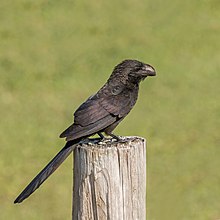The smooth-billed ani (Crotophaga ani) is a bird in the cuckoo family. It is a resident breeding species from southern Florida, the Caribbean, parts of Central America, south to western Ecuador, Brazil, northern Argentina and southern Chile.[2] It was introduced to Galápagos around the 1960s and is potentially impacting native and endemic species across the archipelago.[3]
| Smooth-billed ani | |
|---|---|

| |
| in Grand Cayman | |
| Scientific classification | |
| Domain: | Eukaryota |
| Kingdom: | Animalia |
| Phylum: | Chordata |
| Class: | Aves |
| Order: | Cuculiformes |
| Family: | Cuculidae |
| Genus: | Crotophaga |
| Species: | C. ani
|
| Binomial name | |
| Crotophaga ani | |

| |
Taxonomy
editThe smooth-billed ani was described and illustrated in 1648 by the German naturalist Georg Marcgrave in his Historia Naturalis Brasiliae.[4] He used the name "Ani" but did not explain the origin of the word. It probably comes from the word Anim in the Tupi language which means "social bird".[5] In 1756 the Irish physician Patrick Browne used the name Crotophaga for the species in his The Civil and Natural History of Jamaica.[6] Browne's name combines the Ancient Greek krotōn meaning "tick" with -phagos meaning "-eating".[7] Browne wrote that the smooth-billed anis "live chiefly upon ticks and other small vermin; and may be frequently seen jumping about all cows and oxen in the fields".[6] When the Swedish naturalist Carl Linnaeus updated his Systema Naturae for the tenth edition in 1758 he included the smooth-billed ani. He placed it in its own genus Crotophaga and coined the binomial name Crotophaga ani.[8] The type locality is Jamaica.[9] The species is monotypic: no subspecies are recognised.[10]
Description
editThe smooth-billed ani is a mid-sized species, larger on average than the groove-billed ani but smaller than the greater ani. It measures approximately 35 cm (14 in) in overall length. Males weigh around 115 g (4.1 oz) while females are lighter and with a weight of around 95 g (3.4 oz). The adult is mainly glossy black, with a long tail, deep ridged black bill and a brown iris.[11] The flight is weak and wobbly, but the bird runs well and usually feeds on the ground. This species is called "el pijul" in Venezuelan folklore.[citation needed] The calls include a whining ooo-leeek.
Distribution and habitat
editThis ani is found in open and semi-open country and areas under cultivation. This common and conspicuous species has greatly benefited from deforestation.
Behaviour
editThis is a very gregarious species, always found in noisy groups.
Breeding
editThe nest, built communally by several pairs, is a deep cup lined with leaves and placed usually 2–6 m (6.6–19.7 ft) high in a tree. A number of females lay their chalky blue eggs in the nest and then share incubation and feeding. Each female is capable of laying up to seven eggs, and nests have been found containing up to 29 eggs, but it is rare for more than ten to hatch. Incubation is 13–15 days, with another 10 days to fledging. Up to three broods may be raised in a season, with the young of earlier broods helping to feed more recent chicks.
Food and feeding
editThe smooth-billed ani feeds on termites, large insects, other invertebrates[12] and even lizards, frogs, eggs and hatchlings of other birds, and fruit.[12] They will occasionally remove ticks and other parasites from grazing animals.
Conservation status
editThe smooth-billed ani is considered Least Concern according to the IUCN Red List. Declines in the South Florida population were recorded as the state delayed its protection decision for the species.[13]
Gallery
edit-
Egg, Collection Museum Wiesbaden
-
In Tobago
-
In Jamaica
-
In Dominica
-
In Colombia
References
edit- ^ BirdLife International (2020). "Crotophaga ani". IUCN Red List of Threatened Species. 2020: e.T22684434A168903230. doi:10.2305/IUCN.UK.2020-3.RLTS.T22684434A168903230.en. Retrieved 12 November 2021.
- ^ "Maracaballos de pico liso - AVES DE CHILE". www.avesdechile.cl. Retrieved 2020-08-17.
- ^ Cooke, Sophia C.; Haskell, Lucy E.; van Rees, Charles B.; Fessl, Birgit (January 2019). "A review of the introduced smooth-billed ani Crotophaga ani in Galápagos". Biological Conservation. 229: 38–49. Bibcode:2019BCons.229...38C. doi:10.1016/j.biocon.2018.11.005.
- ^ Marcgrave, Georg (1648). Historia Naturalis Brasiliae: Liber Quintus: Qui agit de Avibus (in Latin). Lugdun and Batavorum (London and Leiden): Franciscum Hackium and Elzevirium. p. 193.
- ^ Jobling 2010, p. 48.
- ^ a b Browne, Patrick (1756). The Civil and Natural History of Jamaica. London: Printed for the author, and sold by T. Osborne and J. Shipton. p. 474.
- ^ Jobling 2010, p. 123.
- ^ Linnaeus, Carl (1758). Systema Naturae per regna tria naturae, secundum classes, ordines, genera, species, cum characteribus, differentiis, synonymis, locis (in Latin). Vol. 1 (10th ed.). Holmiae (Stockholm): Laurentii Salvii. p. 105.
- ^ Peters, James Lee, ed. (1940). Check-List of Birds of the World. Vol. 4. Cambridge, Massachusetts: Harvard University Press. p. 57.
- ^ Gill, Frank; Donsker, David; Rasmussen, Pamela, eds. (January 2022). "Turacos, bustards, cuckoos, mesites, sandgrouse". IOC World Bird List Version 12.1. International Ornithologists' Union. Retrieved 7 August 2022.
- ^ Payne, R.B. (1997). "Smooth-billed ani". In del Hoyo, J.; Elliott, A.; Sargatal, J. (eds.). Handbook of the Birds of the World. Vol. 4: Sandgrouse to Cuckoos. Barcelona, Spain: Lynx Edicions. p. 602. ISBN 978-84-87334-22-1.
- ^ a b "Crotophaga ani (Smooth-billed Ani)" (PDF). Sta.uwi.edu. Retrieved 27 March 2022.
- ^ David Fleshler (25 September 2015). "Rare bird declines in South Florida as state delays protection decision". Sun Sentinel.
Sources
edit- Jobling, James A. (2010). The Helm Dictionary of Scientific Bird Names. London: Christopher Helm. ISBN 978-1-4081-2501-4.
